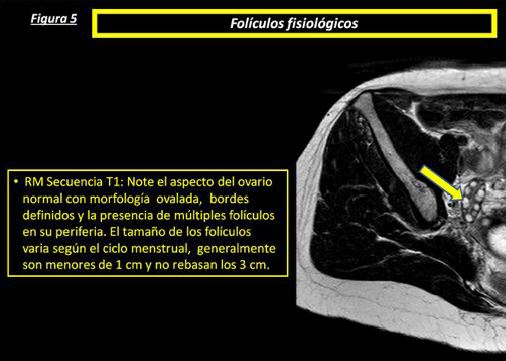Lesiones ováricas más frecuentes.
Un reto por imagen.
Palabras clave:
Lesiones ováricas, poster, seramResumen
Objetivos Docentes
- Revisar y enumerar las lesiones de ovarios más frecuentes centrandonos en las lesiones benignas.
- Analizar y describir los principales signos radiológicos según el método diagnóstico de elección incluyendo Ecografía, TC y RM.
- Enumerar los principales diagnósticos diferenciales de dichas lesiones.
Revisión del tema
Introducción:
El gran avance en las técnicas de imagen en las últimas décadas –incluyendo la ecografía de alta resolución, la tomografía computarizada multidetector (TC) y la resonancia magnética (RM)- ha contribuido a un mejor abordaje diagnóstico nosológico y diferencial de las lesiones del ovario. A pesar de ellos estas lesiones siguen constituyendo un reto diagnóstico en la práctica diaria, por lo que el conocimiento de su etiopatogenia y sus características radiológicas, es imprescindible.
Descargas
Citas
American College of Radiology ACR Appropriateness Criteria. Clinically Suspected Adnexal Mass. Date of origin: 1996 Last review date: 2012 (https://acsearch.acr.org/docs/69466/Narrative/)
Menias CO, Platt JF, Lalchandani UR, Deepak G Bed DG, Khaled M Elsayes KM, Wasnik AP. Multimodality imaging of ovarian cystic lesions: Review with an imaging based algorithmic
approach. World J Radiol 2013; 28; 5(3): 113-25.
Jung SE, Lee JM, Rha SE, et al. CT and MR Imaging of Ovarian Tumors with Emphasis on Differential Diagnosis. RadioGraphics 2002; 22:1305–1325.
Montero FMT Lesiones Benignas de la Pelvis. En: Del Cura JL, Pedraza S, Gayete A. RAdiologia Esencial. 1er ed. Editorial Medica Panamericana; 2010. P.991-1001.
Valentine AL, Gui B, Micco M, Mingote MC, Gaetano AM, Ninivaggi V, Bonomo L. Benign and Suspicious Ovarian Masses—MR Imaging Criteria for Characterization: Pictorial Review. Journal of Oncology Volume 2012 (2012), Article ID 481806, 9 pages http://dx.doi.org/10.1155/2012/481806
Sohaib SA, Sahdev A, Trappen PH, Jacobs IJ,Reznek RH. Characterization of Adnexal Mass Lesions on MR Imaging.. AJR. 2003;180:1297–1304.
Hricak H, Chen M, Coacley FV, et al. Complex Adnexal Masses: Detection and Characterization with MR imaging- Multivariate Analysis. Radiology 2000; 214:39-46.
Funt SA, Hann LE. Detection and caracterization of anexal masses. Radiol Clin N Am. 2002;40: 591-608.
Brown DL, Kika M. Dudiak KD, Laing FC. Adnexal Masses: US Characterization and Reporting.. Radiology. 2010; 254 (2). DOI: http://dx.doi.org/10.1148/radiol.09090552
International Ovarian Tumor Analysis (IOTA). Educational Material. Available at: http://www.iotagroup.org/index.php/educational-material.
Amor F, Vaccaro H, Alcázar JL, León M, Craig JM, Martinez J. Gynecologic Imaging Reporting and Data System. A New Proposal for Classifying Adnexal Masses on the Basis of Sonographic Findings. J Ultrasound Med 2009; 28:285–291.
Levine D, Brown DL, Andreotti RF, et al. Management of Asymptomatic Ovarian and Other Adnexal Cysts Imaged at US: Society of Radiologists in Ultrasound Consensus Conference
Statement. Radiology. 2010;256 (3).
Wasnik AP, Menias CO, Platt JF, et al. Multimodality imaging of ovarian cystic lesions: Review with an imaging based algorithmic approach. World J Radiol. 2013 Mar 28; 5(3): 113–125.
Jeong YY, Outwate EKr,Kang HK.From the RSNA Refresher Courses. Imaging Evaluation of Ovarian Masses. RadioGraphics 2000; 20:1445–1470.
Goodman NF, Cobin RH, Futterweit W, Glueck JS, Legro RS, Carmina E. American Association of Clinical Endocrinologists, American College of Endocrinology, and Androgen Excess and PCOS Society disease state clinical review: guide to the best practices in the evaluation and treatment of polycystic ovary syndrome - part 1. Endocr Pract. 2015 Nov. 21 (11):1291-300.
Busso CE; Soares SR, Pellicer A. Management of ovarian hyperstimulation syndrome. UpToDate, Jun 24, 2015. Available at: http://www.uptodate.com. Accessed February 12, 2016.
Royal College of Obstetricians and G ynaecologists. The Management of Ovarian Hyperstimulation Syndrome. RCOG Green-top Guideline No. 5. Available at: https://www.rcog.org.uk/globalassets/documents/guidelines/green-top-guidelines/gtg_5_ohss.pdf
Daza C, Vargas JA, Ramos J, Mangano AI, Moreno M. Tumor seroso borderline paraovárico. Descripción de un caso. Clin Invest Gin Obst 2004;31(4):136-8.
Bannura G, Contreras J, Peñaloza P. Quiste mesotelial simple gigante abdomino-pélvico. Rev. Chilena de Cirugía.2008;60 (1): 67-70.
Valera ST, Cabezas-Palacios MN, Polo-Velasco A, et al. Adenocarcinoma Mucinoso del Paraovario: un tumor infrecuente. Prog Obstet Ginecol. 2015. http://dx.doi.org/10.1016/j.pog.2015.07.009


